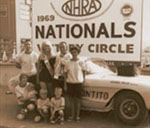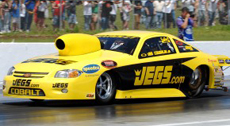The History of CFE

With a die grinder in hand and a lot of ideas in his head, Carl Foltz began a career building horsepower. It all started nearly a quarter-century ago when somebody brought him an engine built by Bill "Grumpy" Jenkins himself. Foltz's custom sheet-metal manifold and his untold hours spent porting the heads and testing and retesting his designs on a flow bench led to the engine having 60 more horsepower when it went back out the door than it had when it came in. A business was born, CFE Racing Products.
The second that racers realized they could pick up the phone and have something better than was on their car, Foltz's phone began ringing. Eventually, big names started calling — really big names. Thousands of dyno pulls and thousands hours spent focusing on the power available to all racing engines through advances in cylinder-head design had John Lingenfelter, Richard Maskin, Joe Gibbs Racing, even General Motors beating a path to Foltz's door.
Before long, CFE was relied upon by top teams from across the broad spectrum of American motorsports. The company's cylinder heads and manifolds have been under the hood of cars at the pinnacle of drag racing, of stock car racing, and of Indy car racing — sometimes all at the same time.

On the quarter-mile, Foltz's products were an integral part of the 1996, 1997, 2000, 2002, 2007 - 2009, 2012 - 2014 - 2015 Pro Stock world championships, two for Jim Yates, five for Jeg Coughlin, one for Mike Edwards, one for Allen Johnson and two for Erica Enders. "That first championship in drag racing, as a supplier for Jim Yates in 1996, was huge," Foltz said. "To compete against the Warren Johnsons of the world was beyond comprehension at the time."
Four years later, CFE-equipped cars won the Pro Stock championship, (Coughlin) the Winston Cup (Bobby Labonte), the Indy 500 (Juan Pablo Montoya), and the Indy Racing League series title (Buddy Lazier) in the same season, unprecedented in the history of racing. CFE drivers did it again in 2002, with Coughlin winning another U.S. Nationals and another Pro Stock championship, world-famous Tony Stewart winning the Winston Cup, Helio Castroneves a second straight Indy 500, and Sam Hornish a second consecutive IRL championship.
"Making more power has been my passion forever, since I was a kid," said Foltz, 45. "You have dreams of accomplishing something like that, but we didn't win those championships — our customers won them. I could give a set a of heads to other people, and they wouldn't win a thing."
Today, Foltz leads a dedicated staff in a state-of-the-art facility using five-axis machining centers. In the beginning, it was just him. "I've been porting heads since I was 15 years old, in the late '70s, which was a great time to start," Foltz said. "That's when flow benches were just coming out."
Foltz's first major drag racing success came at the 1985 Winternationals, when David Nickens and the late Larry Kopp staged in the Comp final, both using CFE sheet-metal manifolds. Foltz was 22. His Comp program took another quantum leap in 1991 when the late John Lingenfelter, who would be one of CFE's most influential customers, made the first six-second pass in a normally aspirated, gas-burning vehicle. His Comp dragster, powered by a 440 cubic-inch, single four-barrel engine with CFE-ported Big Chief Pro Stock heads and a CFE manifold, ran a 6.92 at the Keystone Nationals.
Comp drivers running CFE components hold 34 national records right now. The most dominant driver all year and of all time, David Rampy, heads a Who's Who of racers who have won Comp at NHRA events already this season: David Rampy, Lou Ficco, and Tim Freeman.
"What really got somebody like Maskin to look at us in the first place was our involvement with Lingenfelter," Foltz said. "When he went into the sixes, it really got everyone's attention, and some of what ended up really working in Pro Stock was from technology we developed with John."
For budget-mind racers, there is CFE's latest line, the BMF series, which utilizes CNC technology but allows racers to retain a stock platform, use standard-length valves and stock valvetrain lengths, and run their existing off-the-shelf manifold and stud-mounted rockers. Port sizes and shapes are tailored to the application, which can be anything from small-cubic-inch engines to 600+ cubic-inch behemoths.
With more CNC-porting programs than any facility in the U.S., CFE finds success with completely different kinds of engines in completely different forms of motorsports. CFE's achievements in 500 cubic-inch Pro Stock racing are a world apart from its legacy with the high-winding small-blocks of Pro Stock Truck. When that class was discontinued following the 2001 season, CFE drivers held both ends of the all-time record, Mike Coughlin in elapsed time and Lingenfelter in speed.
Drivers in drag racing classes as varied as Pro Mod, Top Sportsman, Super Gas, and organizations such as PSCA, NMRA, and NMCA also benefit from CFE's expertise, but the company's foundation was built on its success at the highest level of the sport: Pro Stock.

In 1993, Foltz became involved with Yates' operation, which was headed up by master engine builder Richard Maskin. A year later, Yates, who has gone on to become the eighth-winningest driver in Pro Stock history, won his first of 25 professional titles at the 1994 NorthStar Nationals in Brainerd. Since then, there have been an avalanche of CFE wins in Pro Stock — 177 and counting. The some of the hottest drivers in the class this summer — Jeg Coughlin, Allen Johnson, Dave Connolly and Erica Enders — all run CFE heads, as do contenders V. Gaines, Shane Gray, Jonathan Gray, Rodger Brogdon, Steve Kent and Ricky Jones. In America's biggest racing series, NASCAR Nextel Cup competition, CFE has never gone more than a few years without winning a Cup championship. Labonte won the 2000 Cup title, and Stewart won it all in 2002 and 2005 for Joe Gibbs Racing.
In the Indy Racing League, four-valve V-8 GM engines with CFE heads account for countless race wins, scores of pole positions, seven consecutive championships, and the 1997, 1998, 1999, 2000, 2001, and 2002 Indianapolis 500s with drivers Arie Luyendyk, Eddie Cheever, Kenny Brack, Montoya, and Castroneves (twice), respectively.
"The beauty of what we do is that what you learn from all these different applications really does help in other areas," Foltz said. "Not everything — that's the whole thing. You learn what applies to other kinds of racing. Some of it does, and some doesn't. Because we're so diverse, we have an advantage in understanding how to apply different technology to each arena."